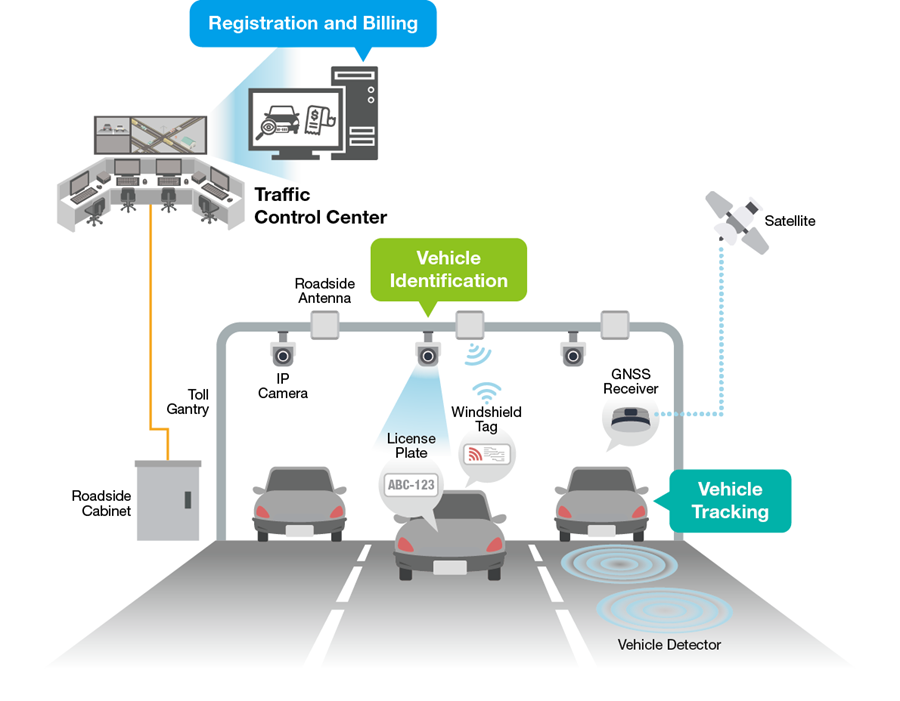Intelligent toll collection (ITC) systems play a pivotal role in alleviating traffic congestion in numerous urban areas. In reality, the global ITC market is slated to expand by 7.7%1 in the coming half-decade. Firm governmental backing serves as one of the catalysts propelling the anticipated growth in this sector. The other noteworthy driver is the heightened utilization of cutting-edge technologies in transportation infrastructure that enable ITC systems to be linked as part of a broader Intelligent Transportation System (ITS) to provide additional features of value essential for the future generation of intelligent expressways.
Despite the substantial initial outlay costs, ITC lanes curtail operational expenses and revenue losses in comparison to conventional booths manned by human toll collectors. Furthermore, ITC allows for vehicle monitoring and the accumulation of valuable insights on road usage, unveiling potential traffic management patterns. With the availability of more relevant data, operators can supervise traffic volumes and implement adaptable tolling strategies to enhance traffic efficacy.
To realize these advantages, real-time vehicle information must be gathered and shared with other applications for evaluation. Essentially, ITC systems nowadays encompass vehicle monitoring, vehicle identification, and backend registration and billing.

- Vehicles can be tracked via the global navigation satellite system (GNSS). Data is acquired from the onboard GNSS receiver or at designated points along toll road sections through field-site sensors like a vehicle detector.
- To authenticate vehicles, vehicle-to-infrastructure communication or license plate recognition (LPR) technologies are employed. Vehicle-to-infrastructure communication can utilize RFID where a UHF antenna/reader reads the windshield tags or leverage GPS to connect with onboard devices (OBU). LPR, conversely, employs cameras that use optical recognition to scan plate numbers.
- Integration with backend infrastructure is also vital. Notably, transportation authorities need to swiftly verify the licensing and registration details of each vehicle to bill the correct driver. A reliable and secure networking solution ensures optimal billing efficiency and customer service.
To interconnect and operate each component of the ITC system seamlessly, it is vital to establish dependable connectivity among all these subsystems and databases. Connectivity assumes a pivotal role in gathering crucial and confidential data and transmitting real-time information between the central operations center and toll routes. Planners and engineers need to take into account the following when constructing a communication network for any ITC system.
Opt for a Compact and Trusty Solution to Link Various Sensors
The vehicle detectors, RFID readers, and cameras deployed in assorted ITC systems can be serial, I/O, or Ethernet-based. They must be linked to an IP network to transmit data to a SCADA system. For the system to function, sensor data has to be validated against vehicle records and plate numbers housed in databases. In this context, factors such as size, mounting options, level of functional integration, and importantly, reliability of communication devices to be installed in space-restricted roadside cabinets, should be carefully deliberated upon. A robust system diminishes operational expenses over its lifecycle as the equipment is primarily deployed in harsh outdoor settings.
Shield Crucial Data During Transfers
Cybersecurity frameworks like the NIST or IEC 62443 standards are implemented to safeguard transportation facilities worldwide against threats to public and data safety. Since ITC systems are integral to public transportation infrastructure, networking devices chosen should adhere to cybersecurity protocols. Initially, device authentication and whitelisting make intrusion attempts arduous to succeed. Utilizing secure communication protocols or VPNs when transmitting sensitive data like payments and driver details can also aid in thwarting unauthorized access, data breaches, and manipulation of the system and records.
Finally, Optimize Network Performance
ITC systems hinge on dependable network performance. Any data packet loss during transmission could compromise data integrity and lead to incorrect toll collection. The network should boast ample transmission bandwidth and range to avoid packet loss due to network congestion. A failover route or network redundancy mechanism should also be implemented to avert network downtime should any of the network ports fail.
The Appropriate Connectivity and Networking Merchandise
As a provider of industrial connectivity and networking solutions, Moxa has assisted numerous customers in connecting and constructing reliable networks for cutting-edge ITC systems in intelligent transportation systems globally. Access our case studies to witness how other enterprises have facilitated reliable communications for their smart ITC systems.
Hunting for the ideal connectivity or networking products for your project? Download our E-book to discover the essential criteria you should factor in when selecting the optimal solution for your requirements.
1 Source: https://www.marketsandmarkets.com/Market-Reports/electronic-toll-collection-system-market-224492059.html
- Not Only for Automobiles: Discovering CANbus Technology in Various Industrial Settings - October 29, 2024
- Boost Your Network Performance: An Exciting Manual to PoE Switches! - September 10, 2024
- Understanding Gigabit Switches: Industrial vs Regular Gigabit - September 4, 2024


